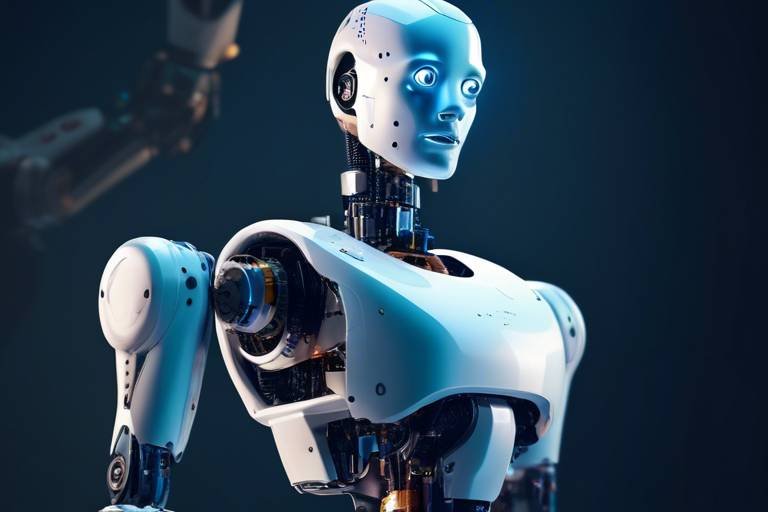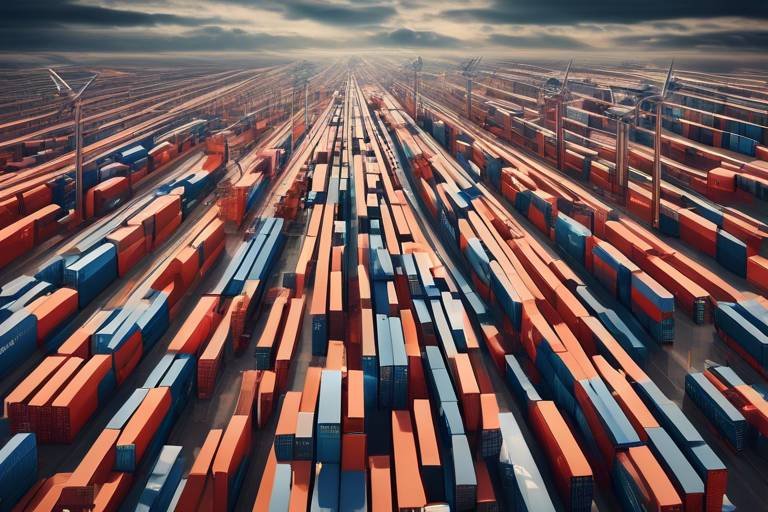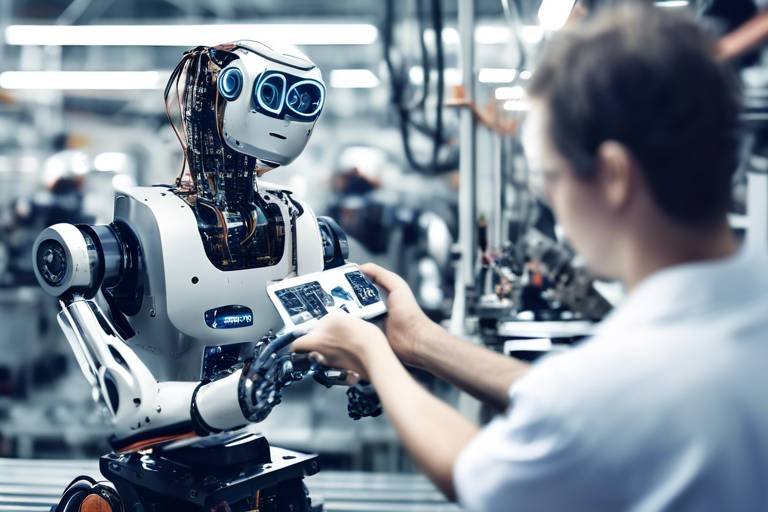The Future of AI in Robotics Development
The emergence of artificial intelligence (AI) has become a game-changer in the field of robotics, paving the way for innovations that were once confined to the realm of science fiction. Imagine a world where machines not only assist us but also learn from their experiences, adapting to new challenges in real-time. This isn't just a dream anymore; it's happening right now. The integration of AI into robotics is transforming industries, enhancing productivity, and reshaping the way we interact with technology in our daily lives.
As we delve into the future of AI in robotics, we will explore how this dynamic duo is revolutionizing various sectors, from manufacturing to healthcare, and even exploration. The ability of robots to operate autonomously, make decisions, and collaborate with humans is not only improving efficiency but also creating new opportunities that were previously unimaginable. However, with these advancements come challenges and ethical considerations that we must address to ensure a balanced and responsible integration of AI in our lives.
In this article, we will uncover the current trends in robotics fueled by AI, examine the rise of collaborative robots, and discuss the ethical implications of these technologies. By understanding the potential and limitations of AI in robotics, we can better prepare for a future where humans and machines work side by side to tackle complex problems and enhance our quality of life.
AI enhances robotics by enabling machines to learn from data, adapt to their environments, and perform complex tasks autonomously. This capability significantly improves efficiency and functionality across various applications. For instance, imagine a robot in a warehouse that can learn the layout, identify products, and optimize its path for picking items. This level of adaptability not only speeds up operations but also reduces human error, leading to increased productivity.
Moreover, AI-powered robots can process vast amounts of data in real-time, allowing them to make informed decisions quickly. This capability is particularly beneficial in scenarios where time is critical, such as in emergency response situations or during complex manufacturing processes. As AI continues to evolve, we can expect robots to take on even more sophisticated roles, further blurring the lines between human and machine capabilities.
The integration of AI in robotics is driving trends that are reshaping industries and workflows. One of the most notable trends is the rise of automation. Businesses are increasingly adopting AI-driven robots to perform repetitive tasks, allowing human workers to focus on more complex and creative endeavors. This shift not only boosts productivity but also enhances job satisfaction among employees.
Another trend is the development of collaborative robots, often referred to as cobots. These robots are designed to work safely alongside humans, combining the strengths of both to enhance productivity while ensuring worker safety. For example, in a manufacturing setting, a cobot might assist a human worker in assembling products, taking on the heavy lifting while the human focuses on quality control and precision tasks.
As industries continue to evolve, the need for cobots has become increasingly evident. These machines are not just tools; they are partners in the workplace, designed to enhance human capabilities rather than replace them. By leveraging AI, cobots can learn from their human counterparts, adapting to their work styles and preferences, which leads to a more harmonious and efficient working environment.
Cobots are making waves across various sectors, demonstrating their versatility and adaptability. Here are some key applications:
- Manufacturing: Cobots assist in assembly lines, performing tasks like screwing, welding, and packaging.
- Healthcare: In hospitals, cobots can help with patient care, medication delivery, and even surgical assistance.
- Agriculture: Cobots are used for planting, harvesting, and monitoring crops, increasing efficiency in food production.
Despite their numerous benefits, integrating cobots into existing workflows poses challenges. Some of these include:
- Safety Concerns: Ensuring that cobots operate safely alongside humans is paramount, requiring rigorous testing and protocols.
- Workforce Training: Employees need training to effectively collaborate with cobots, which can involve a learning curve.
- Human-Robot Interaction: Developing effective communication strategies between humans and robots is essential for seamless collaboration.
On the other side of the spectrum are AI-driven autonomous robots. These machines leverage AI to navigate and operate independently in dynamic environments. They are invaluable in sectors like logistics, agriculture, and exploration, where human presence may be limited or hazardous. For instance, autonomous drones are being used to survey vast areas for environmental monitoring, while self-driving vehicles are revolutionizing transportation.
As AI technology evolves, ethical concerns surrounding privacy, job displacement, and decision-making in autonomous systems arise. It's crucial to engage in discussions about responsible AI development and deployment in robotics. After all, with great power comes great responsibility.
The rise of AI-driven robots raises valid questions about job displacement in various sectors. While automation can lead to increased efficiency, it also necessitates a proactive approach to workforce reskilling and adaptation strategies. Businesses and governments must work together to ensure that the workforce is prepared for the changes ahead, fostering a balanced economic future.
Furthermore, the integration of AI in robotics brings forth privacy and security challenges. As robots collect data and enhance surveillance capabilities, robust regulations are necessary to protect individuals and organizations from potential misuse. Striking the right balance between innovation and privacy is essential for fostering public trust in these technologies.
Looking ahead, advancements in AI and robotics promise to revolutionize industries, enhance human capabilities, and create new opportunities. However, it is imperative that we carefully consider the ethical and societal implications of these technologies. By fostering a collaborative approach between humans and machines, we can unlock the full potential of AI in robotics, ensuring a future that is beneficial for all.
1. What are collaborative robots (cobots)?
Cobots are robots designed to work alongside humans, enhancing productivity while ensuring safety.
2. How does AI improve robotics?
AI enables robots to learn from data, adapt to their environments, and perform complex tasks autonomously.
3. What industries are most impacted by AI in robotics?
Industries such as manufacturing, healthcare, and agriculture are experiencing significant transformations due to AI integration.
4. What are the ethical concerns related to AI in robotics?
Key concerns include job displacement, privacy issues, and the need for responsible decision-making in autonomous systems.

The Role of AI in Robotics
Artificial Intelligence (AI) is not just a buzzword; it’s a game-changer in the field of robotics. Imagine a world where machines can learn from their surroundings, adapt to new situations, and make decisions on their own. Sounds like science fiction, right? Well, it’s happening now! AI enhances robotics by enabling machines to perform complex tasks autonomously, which significantly improves efficiency and functionality across various applications. For instance, robots equipped with AI can analyze vast amounts of data in real-time, allowing them to optimize their operations and reduce human error.
One of the most exciting aspects of AI in robotics is its ability to learn from experience. Through machine learning algorithms, robots can refine their performance over time. They start by analyzing data, identifying patterns, and making predictions based on their findings. This means that the more they operate, the smarter they become! Think of it as teaching a child to ride a bike; the first few attempts may be wobbly, but with practice, they get better and more confident.
Furthermore, AI enables robots to adapt to their environments. This adaptability is crucial in industries such as manufacturing, where robots must navigate complex assembly lines filled with human workers and other machines. An AI-driven robot can adjust its movements based on the actions of its human counterparts, ensuring a seamless workflow. It’s like having a dance partner who knows your every move and adjusts accordingly to keep the rhythm going.
In addition to learning and adapting, AI-powered robots can also perform tasks that are deemed too dangerous or tedious for humans. For example, in the field of agriculture, autonomous robots equipped with AI can monitor crop health, identify pests, and even harvest produce without human intervention. This not only boosts productivity but also minimizes the risk of injury to workers.
To illustrate the transformative role of AI in robotics, consider the following table that highlights some key functionalities enabled by AI:
| Functionality | Description |
|---|---|
| Learning | Robots can analyze data and improve their tasks over time. |
| Adaptability | Machines can adjust their operations based on real-time conditions. |
| Autonomy | Robots can operate independently in various environments. |
| Safety | AI enables robots to perform dangerous tasks, reducing human risk. |
In conclusion, the integration of AI into robotics is not just enhancing the capabilities of machines; it’s redefining the very nature of work. As we move forward, the potential for AI in robotics is limitless, paving the way for innovations that can transform industries and improve our daily lives. The future looks bright, and with AI steering the ship, we are bound to witness extraordinary advancements in the robotics landscape.

Current Trends in Robotics
The world of robotics is currently experiencing a seismic shift, largely fueled by the integration of artificial intelligence. This fusion is not just a technological advancement; it’s a revolution that is reshaping how industries operate and how humans interact with machines. One of the most significant trends is the move towards increased automation. Companies are increasingly relying on robots to handle repetitive tasks, allowing human workers to focus on more complex and creative endeavors. This shift not only enhances productivity but also reduces the risk of human error.
Another exciting trend is the rise of smart manufacturing. Factories are becoming more intelligent, utilizing AI-driven robots that can adapt to changes in production lines and optimize their performance in real-time. Imagine a factory floor where machines can communicate with each other, adjusting their operations based on current demands and supply chain fluctuations. This level of responsiveness is not just a dream; it’s becoming a reality as AI algorithms evolve.
Moreover, we are witnessing the emergence of collaborative robots, commonly known as cobots. These robots are designed to work alongside humans, enhancing productivity while ensuring safety. Cobots are equipped with sensors and AI capabilities that allow them to understand their human counterparts' movements and intentions. This synergy between human and robot not only improves operational efficiency but also creates a more dynamic workplace. For instance, in assembly lines, cobots can assist workers by lifting heavy parts or performing tasks that require precision, thus enabling humans to concentrate on more intricate aspects of the production process.
As we delve deeper into the realm of robotics, it’s essential to consider the implications of these trends on various sectors. From healthcare to logistics, the integration of AI and robotics is paving the way for innovative solutions. In healthcare, robots are assisting in surgeries and patient care, while in logistics, autonomous robots are optimizing warehouse operations and delivery systems. The impact is profound, and the possibilities are endless.
However, with these advancements come challenges that need to be addressed. Companies must navigate the complexities of integrating these technologies into existing workflows. For instance, while cobots can significantly enhance productivity, they also require careful planning to ensure they complement human workers effectively. Organizations must invest in training programs to equip their workforce with the skills needed to collaborate with these advanced machines.
In summary, the current trends in robotics are not just about technology; they are about redefining how we work and interact with machines. The rise of automation, smart manufacturing, and collaborative robots signifies a new era where humans and machines coexist harmoniously. As we embrace these changes, it’s crucial to remain vigilant about the ethical implications and ensure that the future of work is inclusive and beneficial for all.
- What are collaborative robots (cobots)? Cobots are robots designed to work alongside humans, enhancing productivity while ensuring safety.
- How is AI changing the manufacturing industry? AI is enabling smarter manufacturing processes, allowing robots to adapt in real-time to production changes.
- What challenges do companies face when integrating cobots? Companies must address safety concerns, workforce training, and effective human-robot interaction strategies.
- What sectors are benefiting from AI-driven robotics? Sectors such as healthcare, logistics, and manufacturing are seeing significant benefits from AI-driven robotics.

Collaborative Robots (Cobots)
The emergence of Collaborative Robots, commonly known as cobots, marks a significant milestone in the evolution of robotics. Unlike traditional industrial robots that often operate in isolation, cobots are designed to work alongside humans, enhancing productivity while prioritizing safety. Imagine a factory floor where machines and humans seamlessly collaborate, much like a well-rehearsed dance; this is the future cobots promise. By integrating advanced artificial intelligence with robotic systems, cobots can learn from their human counterparts, adapt to changing tasks, and even respond to real-time feedback, creating an environment of mutual support.
One of the most compelling aspects of cobots is their versatility. These robots can be deployed across various industries, from manufacturing to healthcare, performing tasks that range from simple assembly to complex surgical procedures. For instance, in an automotive assembly line, a cobot might assist a human worker by lifting heavy parts, thereby reducing physical strain and increasing efficiency. In healthcare settings, cobots can help in patient care, such as delivering medication or assisting with mobility, allowing healthcare professionals to focus on more critical tasks.
However, the integration of cobots into existing workflows is not without its challenges. Companies must address several factors to ensure a smooth transition. These include:
- Safety Concerns: Ensuring that cobots can operate safely around humans is paramount. This involves implementing advanced sensors and safety protocols that allow cobots to detect human presence and react accordingly.
- Workforce Training: Human workers need to be adequately trained to interact with cobots. Understanding how to work alongside these machines is crucial for maximizing their benefits.
- Human-Robot Interaction Strategies: Developing effective communication methods between humans and cobots is essential. This could involve using intuitive interfaces or voice commands to facilitate collaboration.
Despite these challenges, the potential benefits of cobots are enormous. They not only enhance operational efficiency but also create a safer working environment. By taking over repetitive and physically demanding tasks, cobots allow human workers to engage in more fulfilling and intellectually stimulating activities. As we continue to innovate and refine these technologies, the future looks bright for collaborative robots, paving the way for a new era of human-robot cooperation.

Applications of Cobots
Collaborative robots, or cobots, are revolutionizing the way industries operate by seamlessly integrating into various workflows. Their versatility is nothing short of impressive, as they can be found in a multitude of settings, each tailored to enhance productivity and efficiency. Imagine a bustling assembly line where cobots work side-by-side with human workers, handling repetitive tasks while allowing their human counterparts to focus on more complex and creative endeavors. This synergy not only boosts operational efficiency but also fosters a safer work environment.
One of the most notable applications of cobots is in the manufacturing sector. Here, they assist with tasks such as packaging, sorting, and quality control. By taking on these repetitive tasks, cobots reduce the physical strain on human workers, thereby minimizing the risk of injury and fatigue. Additionally, cobots can operate continuously without the need for breaks, significantly increasing overall productivity. For instance, in automotive manufacturing, cobots are used for assembling parts, ensuring precision and speed that enhance the production process.
In the healthcare industry, cobots are making waves as well. They are employed in surgical procedures, assisting surgeons with precision tasks that require steady hands and attention to detail. Cobots can also be utilized in patient care, where they help with lifting and transporting patients, allowing healthcare professionals to devote more time to direct patient interaction. This application not only improves patient outcomes but also enhances the overall workflow in medical facilities.
Another fascinating application of cobots is in the field of logistics. Here, cobots are used for inventory management, picking, and packing goods in warehouses. They can navigate through aisles, identify items, and even communicate with human workers to streamline the process. This capability is particularly beneficial in e-commerce, where the demand for quick and accurate order fulfillment is paramount. By automating these tasks, companies can significantly reduce operational costs and improve delivery times.
To illustrate the diverse applications of cobots, consider the following table:
| Industry | Application | Benefits |
|---|---|---|
| Manufacturing | Assembly, Packaging, Quality Control | Increased efficiency, Reduced strain on workers |
| Healthcare | Surgical Assistance, Patient Transport | Enhanced precision, Improved patient care |
| Logistics | Inventory Management, Picking, Packing | Cost reduction, Faster delivery |
In summary, the applications of cobots span across various industries, each demonstrating their ability to enhance productivity while ensuring safety and efficiency. As technology continues to evolve, we can expect to see even more innovative uses for collaborative robots, further integrating them into our daily work lives. The future looks bright for cobots, and their role in transforming industries is only just beginning.
- What are cobots? Cobots, or collaborative robots, are designed to work alongside humans safely and efficiently.
- How do cobots enhance productivity? They take over repetitive tasks, allowing human workers to focus on more complex and creative responsibilities.
- In which industries are cobots commonly used? Cobots are widely used in manufacturing, healthcare, logistics, and many other sectors.
- Are cobots safe to work with? Yes, cobots are designed with safety features that allow them to work alongside humans without posing a threat.

Challenges of Implementing Cobots
The rise of collaborative robots, or cobots, is undeniably reshaping the modern workplace, but their implementation isn't without its challenges. One of the most pressing issues is safety concerns. While cobots are designed to work alongside humans, there remains a fear of accidents or malfunctions that could lead to injuries. Ensuring that these robots can detect human presence and respond appropriately is a complex engineering task that requires rigorous testing and validation.
Another significant hurdle is workforce training. Employees need to be adequately trained not just to work with cobots but to understand their functionalities and limitations. This training is essential to foster a collaborative environment where humans and robots can work together seamlessly. Companies must invest time and resources into developing training programs that cater to the unique needs of their workforce, which can be a daunting task, especially for smaller businesses.
Human-robot interaction strategies also pose a challenge. As cobots become more integrated into daily operations, the need for effective communication between humans and machines becomes paramount. This includes developing intuitive interfaces that allow workers to easily control and interact with cobots. Without proper interaction strategies, there is a risk of miscommunication, which can lead to inefficiencies and even accidents on the job.
Additionally, there are financial considerations. The initial investment in cobots can be substantial, and companies must weigh the potential return on investment against the costs of implementation. Factors such as maintenance, software updates, and the need for ongoing training can add to the overall expenditure, making it crucial for businesses to conduct thorough cost-benefit analyses before diving into cobot adoption.
Lastly, there is the challenge of cultural acceptance. In many industries, there is a longstanding perception that robots could replace human jobs, leading to resistance from employees. Overcoming this mindset requires effective communication from leadership about the benefits of cobots—not just for the company, but for workers as well. When employees see cobots as tools that enhance their work rather than replace it, the transition can be much smoother.
In summary, while cobots hold immense potential to boost productivity and efficiency, their implementation comes with a unique set of challenges. Addressing safety, training, interaction strategies, financial implications, and cultural acceptance will be vital for organizations looking to harness the full power of collaborative robotics.
- What are cobots? Collaborative robots designed to work alongside humans in a shared workspace.
- How do cobots enhance productivity? By automating repetitive tasks, allowing human workers to focus on more complex responsibilities.
- What are the safety measures for cobots? Cobots are equipped with sensors and software to detect human presence and respond accordingly to prevent accidents.
- What industries benefit from cobots? Industries such as manufacturing, healthcare, and logistics are increasingly adopting cobots for enhanced efficiency.
- How can companies overcome resistance to cobots? By communicating the benefits of cobots and providing thorough training to employees.

AI-Driven Autonomous Robots
Imagine a world where machines can operate independently, navigating complex environments without human intervention. This is not science fiction; it’s the reality brought forth by . These remarkable machines utilize sophisticated algorithms and advanced sensors to perceive their surroundings, make decisions, and execute tasks in real-time. From warehouses to agricultural fields, the potential applications for these robots are vast and varied, revolutionizing how we approach work and productivity.
One of the most exciting aspects of AI-driven autonomous robots is their ability to learn from experience. Through a process known as machine learning, these robots can analyze data from their operations, adjusting their behavior to improve efficiency and effectiveness. For example, a delivery robot might learn the most efficient routes to take based on traffic patterns and obstacles it encounters, ultimately saving time and resources. This adaptability makes them invaluable in dynamic environments where conditions can change rapidly.
Moreover, the integration of AI in these robots allows for enhanced decision-making capabilities. They can assess risks, prioritize tasks, and even collaborate with other machines to optimize workflows. In sectors like logistics, autonomous robots are transforming operations by automating the movement of goods, reducing human error, and increasing throughput. Consider a warehouse where drones autonomously manage inventory, transporting items from one location to another without the need for human oversight. This not only streamlines processes but also frees up human workers to focus on more complex and creative tasks.
However, the deployment of AI-driven autonomous robots is not without its challenges. For instance, ensuring safety in environments where humans and robots interact is paramount. Autonomous robots must be equipped with advanced sensors and safety protocols to prevent accidents. Additionally, there are technical challenges associated with navigation and obstacle avoidance, especially in unpredictable settings. The technology is advancing rapidly, but there is still work to be done to ensure these machines can operate safely and effectively alongside humans.
As we look to the future, the possibilities for AI-driven autonomous robots are limitless. They have the potential to redefine industries and enhance productivity in ways we are just beginning to understand. However, with this potential comes the responsibility to address ethical considerations, such as job displacement and privacy concerns. As these robots become more integrated into our daily lives, it is crucial to engage in discussions about their role in society and the implications of their widespread use.
- What are AI-driven autonomous robots?
AI-driven autonomous robots are machines that use artificial intelligence to operate independently, navigating their environments and performing tasks without human intervention. - Where are these robots typically used?
They are commonly used in logistics, agriculture, healthcare, and exploration, among other sectors, to automate processes and improve efficiency. - What are the main challenges of implementing these robots?
Some challenges include ensuring safety, overcoming technical obstacles in navigation, and addressing ethical concerns related to job displacement and privacy. - How do these robots learn and adapt?
They utilize machine learning algorithms to analyze data from their operations, allowing them to improve their performance over time.

Ethical Considerations in AI and Robotics
The rapid evolution of artificial intelligence in the realm of robotics brings forth a myriad of ethical considerations that society must grapple with. As we integrate AI into machines that can make decisions and perform tasks autonomously, we must ask ourselves: what are the implications of these technologies on our daily lives and the future of work? The conversation around ethics in AI and robotics is not merely an academic exercise; it is a pressing issue that affects everyone, from tech developers to everyday users.
One of the most significant ethical dilemmas revolves around privacy. With the increasing capability of robots to collect data, monitor environments, and even analyze human behavior, we must consider how this information is used. Are individuals aware of the data being collected? Is their consent obtained? The potential for misuse of personal information is a real concern that calls for stringent regulations. For instance, in sectors like healthcare, where robots might handle sensitive patient data, ensuring confidentiality becomes paramount.
Moreover, the rise of AI-driven robots raises questions about job displacement. As machines become capable of performing tasks traditionally done by humans, we face a significant shift in the job market. While automation can lead to increased efficiency and lower costs for businesses, it also poses a threat to job security for many workers. This situation necessitates a proactive approach to workforce reskilling and adaptation. Companies and governments need to collaborate in developing training programs that equip individuals with the skills necessary to thrive in an increasingly automated world.
Another critical aspect of the ethical landscape is the decision-making capabilities of autonomous systems. When robots are tasked with making choices, particularly in life-and-death situations, how do we ensure they make ethical decisions? For example, consider self-driving cars: in the event of an unavoidable accident, what criteria should the AI use to determine whom to prioritize for safety? These scenarios demand a robust ethical framework that guides the development of AI algorithms to ensure they align with human values.
To address these concerns, the robotics industry is beginning to implement ethical guidelines and frameworks. Here’s a brief overview of key ethical considerations:
- Transparency: Ensuring that AI systems operate in a way that is understandable to users.
- Accountability: Establishing who is responsible when AI systems fail or cause harm.
- Fairness: Preventing biases in AI algorithms that could lead to discrimination.
- Human Oversight: Maintaining a level of human control over autonomous systems to prevent unintended consequences.
As we look to the future of AI in robotics, it is vital to foster a dialogue among stakeholders, including technologists, ethicists, policymakers, and the public. By addressing these ethical considerations head-on, we can harness the transformative power of AI while ensuring it serves humanity's best interests. The path forward must be paved with caution, foresight, and a commitment to ethical practices that prioritize human dignity and societal well-being.
Q1: What are the primary ethical concerns in AI and robotics?
A1: The main concerns include privacy, job displacement, decision-making ethics, and accountability for autonomous actions.
Q2: How can we ensure that AI systems are transparent?
A2: Implementing clear guidelines and standards for AI operations, as well as educating users about how these systems work, can enhance transparency.
Q3: What role does human oversight play in autonomous robots?
A3: Human oversight is crucial for monitoring AI decisions and intervening when necessary, ensuring that ethical standards are upheld.
Q4: How can workers be reskilled for an automated future?
A4: Companies and governments should collaborate to create training programs that focus on skills relevant to a technology-driven economy.

Job Displacement and Workforce Impact
The rise of AI-driven robots is undeniably reshaping the workforce landscape, bringing with it a wave of concern about job displacement across various sectors. As machines become more capable of performing tasks traditionally done by humans, the fear of losing jobs to automation becomes a pressing issue. It's almost like watching a magic trick unfold—one moment, a task is being done by a human, and the next, a robot seamlessly takes over, leaving many wondering what this means for their future employment.
Let's break it down: while AI and robotics can enhance productivity and efficiency, they also pose significant challenges for workers. Many jobs, especially those that involve repetitive tasks, are at risk of being automated. For instance, in manufacturing, robots can assemble products faster and with greater precision than their human counterparts. This shift raises an important question: how do we balance the benefits of technological advancement with the need for meaningful employment?
To address these concerns, it's essential to focus on reskilling and upskilling the workforce. Companies and governments must invest in training programs that equip workers with the skills needed to thrive in a technology-driven environment. This could involve teaching employees how to work alongside robots, manage AI systems, or even transition to entirely new roles that focus on creativity and critical thinking—areas where humans still excel. For example, a factory worker might learn to operate and maintain robotic systems, thus transforming their role rather than replacing it.
Moreover, the impact of AI on jobs isn't uniform across all sectors. Some industries may see job growth as new roles emerge. For instance, the tech sector is likely to expand, creating opportunities for AI developers, data analysts, and robotic engineers. The key is to recognize that while some jobs may disappear, others will be created, leading to a shift in the types of skills that are in demand.
Here’s a quick snapshot of potential job changes in various sectors:
| Industry | Job Impact |
|---|---|
| Manufacturing | Reduction in assembly line jobs; increase in robot maintenance roles |
| Healthcare | Automation of administrative tasks; increased demand for patient care roles |
| Transportation | Decline in driving jobs; growth in logistics management positions |
| Retail | Decrease in cashier roles; rise in customer service and tech support jobs |
As we navigate this transition, it’s crucial to foster a culture of adaptability and lifelong learning. Workers should be encouraged to embrace change rather than resist it. After all, the future of work is not about choosing between humans and machines; it's about finding a way for both to coexist and thrive together.
In conclusion, while the threat of job displacement due to AI and robotics is real, it also opens up a dialogue about the evolution of work. By prioritizing education and training, we can help ensure that the workforce is prepared for the changes ahead, allowing society to reap the benefits of technological advancements without leaving anyone behind.
- Will AI completely replace human jobs? While AI will automate certain tasks, it will also create new jobs that require human skills.
- What can workers do to prepare for changes in their jobs? Workers should focus on reskilling and upskilling to adapt to new technologies and roles.
- How can companies support their employees during this transition? Companies can provide training programs and resources to help workers learn new skills.
- Are there sectors where AI is likely to create more jobs? Yes, sectors like technology and healthcare are expected to see job growth as new roles emerge.

Privacy and Security Issues
The integration of artificial intelligence in robotics has undoubtedly opened up a world of possibilities, but it also brings a host of privacy and security concerns that cannot be ignored. As robots become smarter and more autonomous, they often rely on vast amounts of data to function effectively. This data can include sensitive information about individuals, which raises significant questions about how this data is collected, stored, and used.
For instance, consider the way autonomous delivery robots operate. They navigate through urban environments, collecting data about their surroundings, including images and even personal information from bystanders. If this data falls into the wrong hands, it could lead to serious privacy violations. Moreover, the potential for surveillance becomes a pressing issue. With the capability to monitor and record activities, these robots can inadvertently contribute to a society where individuals are constantly watched.
Another critical aspect to consider is the security of the systems that control these robots. Cybersecurity threats are rampant, and as robots become more connected, they become attractive targets for hackers. A successful breach could allow malicious actors to take control of a robot, leading to disastrous consequences, from theft to physical harm. This highlights the need for robust security measures that protect not only the robots themselves but also the data they handle.
To address these challenges, developers and organizations must adopt comprehensive strategies that prioritize data protection and user privacy. This involves implementing strict data governance policies and ensuring compliance with regulations such as the General Data Protection Regulation (GDPR). Additionally, involving stakeholders in discussions about ethical AI development can help create a framework that balances innovation with responsibility.
In summary, while the future of AI in robotics holds incredible promise, it is crucial to navigate the accompanying privacy and security issues with caution. As we embrace these technologies, we must also advocate for transparency and accountability to safeguard our rights and ensure a secure technological landscape.
- What are the main privacy concerns associated with AI in robotics? Privacy concerns primarily revolve around data collection, surveillance, and the potential misuse of sensitive information.
- How can organizations ensure data security in robotic systems? Organizations can implement strong cybersecurity measures, conduct regular audits, and comply with data protection regulations to safeguard data.
- What role do regulations play in addressing privacy issues? Regulations like GDPR set standards for data protection, ensuring that organizations are held accountable for how they handle personal information.
- What are the potential consequences of a privacy breach in robotics? Privacy breaches can lead to identity theft, unauthorized surveillance, and a loss of public trust in robotic technologies.

The Future Landscape of AI in Robotics
The future of artificial intelligence (AI) in robotics is not just a glimpse into a sci-fi fantasy; it’s a rapidly approaching reality that promises to reshape how we interact with technology and the world around us. Imagine a world where robots are not merely tools but partners in innovation, enhancing our capabilities and taking on tasks that were once deemed too dangerous or complex for humans. As we stand on the brink of this transformative era, several key trends and developments are emerging that will define the landscape of AI in robotics.
One of the most exciting prospects is the **integration of advanced machine learning algorithms** into robotic systems. These algorithms will empower robots to learn from their experiences, adapt to new situations, and make decisions based on real-time data. For instance, in logistics, autonomous robots equipped with AI can optimize their routes based on traffic patterns or warehouse conditions, leading to significant cost savings and efficiency gains. This kind of adaptability is crucial as industries demand more flexible and responsive operations.
Moreover, the rise of **swarm robotics** is another fascinating trend. This concept draws inspiration from nature, where groups of simple agents, like ants or bees, work together to achieve complex tasks. In the future, we could see fleets of drones or ground robots collaborating seamlessly to perform tasks like search and rescue missions, environmental monitoring, or even agricultural harvesting. This collective intelligence will not only enhance operational efficiency but also allow for more resilient and scalable solutions in various sectors.
However, with these advancements come significant challenges that must be addressed. As robots become more autonomous, the question of **ethical programming** arises. How do we ensure that AI systems make decisions that align with human values? This is especially pertinent in areas like healthcare, where robots might be tasked with making life-or-death decisions. The development of ethical frameworks and guidelines will be essential to navigate these complexities, ensuring that technology serves humanity rather than undermining it.
Furthermore, **collaboration between humans and robots** will take on new dimensions. Imagine a workplace where AI-driven robots not only assist in tasks but also enhance human creativity and problem-solving abilities. This symbiotic relationship could lead to unprecedented levels of productivity and innovation. As we look to the future, fostering an environment where humans and robots can work together harmoniously will be crucial. Training programs and educational initiatives will need to evolve to prepare the workforce for this new reality.
In conclusion, the future landscape of AI in robotics is filled with potential and promise. As we continue to innovate and push the boundaries of what is possible, it’s vital to keep the conversation going about the ethical, social, and economic implications of these technologies. The journey ahead will be as much about understanding our relationship with machines as it is about the machines themselves.
- What are the primary benefits of AI in robotics? AI enhances robotics by enabling machines to perform complex tasks autonomously, improving efficiency, safety, and productivity across various industries.
- How will AI impact jobs in the future? While AI may automate certain jobs, it will also create new opportunities, necessitating workforce reskilling and adaptation to ensure a balanced economic future.
- What ethical considerations should we keep in mind? Key ethical concerns include privacy, job displacement, and ensuring that AI systems make decisions aligned with human values.
- What is swarm robotics? Swarm robotics is a concept where multiple robots work together to complete tasks, inspired by the behavior of social insects like ants and bees.
Frequently Asked Questions
- What is the role of AI in robotics?
AI plays a crucial role in robotics by enabling machines to learn from data, adapt to their surroundings, and perform complex tasks autonomously. This enhances efficiency and functionality across various applications, making robots smarter and more capable than ever before.
- What are collaborative robots (cobots)?
Collaborative robots, or cobots, are designed to work safely alongside humans. They combine the power of AI and robotics to enhance productivity while ensuring worker safety. Cobots are becoming essential in modern workplaces, allowing for a seamless blend of human and robotic efforts.
- What challenges do cobots face during implementation?
While cobots offer numerous benefits, their integration into existing workflows can pose challenges. These include safety concerns, the need for workforce training, and developing effective human-robot interaction strategies to ensure smooth collaboration.
- How do autonomous robots utilize AI?
Autonomous robots leverage AI to navigate and operate independently in dynamic environments. This capability makes them invaluable in sectors like logistics, agriculture, and exploration, where human presence may be limited or hazardous.
- What ethical considerations arise with AI in robotics?
As AI technology evolves, ethical concerns related to privacy, job displacement, and decision-making in autonomous systems come to the forefront. It's essential to engage in discussions about responsible AI development and deployment in robotics to address these issues.
- Will AI-driven robots displace jobs?
The rise of AI-driven robots raises valid concerns about job displacement across various sectors. This necessitates the need for workforce reskilling and adaptation strategies to ensure a balanced economic future, allowing humans and robots to coexist effectively.
- What privacy and security issues are associated with AI in robotics?
The integration of AI in robotics increases data collection and surveillance capabilities, leading to privacy and security challenges. It is crucial to implement robust regulations to protect individuals and organizations from potential misuse of data.
- What does the future hold for AI in robotics?
The future of AI in robotics is promising, with advancements set to revolutionize industries, enhance human capabilities, and create new opportunities. However, careful consideration of ethical and societal implications will be essential to navigate this evolving landscape responsibly.



















